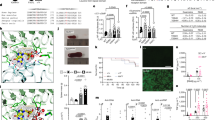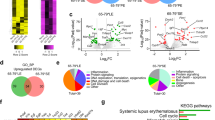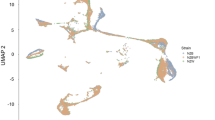Abstract
Systemic lupus erythematosus is a chronic multi-organ autoimmune disease marked mainly by the production of anti-nuclear antibodies. Nuclear antigens become accessible to the immune system following apoptosis and defective clearance of apoptotic debris has been shown in several knockout mouse models to promote lupus. However, genetic loci associated with defective clearance are not well defined in spontaneously arising lupus models. We previously showed that introgression of the chromosome 13 interval from lupus-prone New Zealand Black (NZB) mice onto a non-autoimmune B6 genetic background (B6.NZBc13) recapitulated many of the NZB autoimmune phenotypes. Here, we show that B6.NZBc13 mice have impaired clearance of apoptotic debris by peritoneal and tingible-body macrophages and have narrowed down the chromosomal interval of this defect using subcongenic mice with truncated NZB chromosome 13 intervals. This chromosomal region (81–94 Mb) is sufficient to produce polyclonal B- and T-cell activation, and expansion of dendritic cells. To fully recapitulate the autoimmune phenotypes seen in B6.NZBc13 mice, at least one additional locus located in the centromeric portion of the interval is required. Thus, we have identified a novel lupus susceptibility locus on NZB chromosome 13 that is associated with impaired clearance of apoptotic debris.
This is a preview of subscription content, access via your institution
Access options
Subscribe to this journal
Receive 6 digital issues and online access to articles
$119.00 per year
only $19.83 per issue
Buy this article
- Purchase on Springer Link
- Instant access to full article PDF
Prices may be subject to local taxes which are calculated during checkout





Similar content being viewed by others
References
Kotzin BL . Systemic lupus erythematosus. Cell 1996; 85: 303–306.
Theofilopoulos AN, Dixon FJ . Murine models of systemic lupus erythematosus. Adv Immunol 1985; 37: 269–390.
Chiang BL, Bearer E, Ansari A, Dorshkind K, Gershwin ME . The BM12 mutation and autoantibodies to dsDNA in NZB.H-2bm12 mice. J Immunol 1990; 145: 94–101.
Cheung YH, Loh C, Pau E, Kim J, Wither J . Insights into the genetic basis and immunopathogenesis of systemic lupus erythematosus from the study of mouse models. Semin Immunol 2009; 21: 372–382.
Wither JE, Loh C, Lajoie G, Heinrichs S, Cai YC, Bonventi G et al. Colocalization of expansion of the splenic marginal zone population with abnormal B cell activation and autoantibody production in B6 mice with an introgressed New Zealand Black chromosome 13 interval. J Immunol 2005; 175: 4309–4319.
Loh C, Pau E, Chang NH, Wither JE . An intrinsic B-cell defect supports autoimmunity in New Zealand black chromosome 13 congenic mice. Eur J Immunol 2011; 41: 527–536.
Munoz LE, Lauber K, Schiller M, Manfredi AA, Herrmann M . The role of defective clearance of apoptotic cells in systemic autoimmunity. Nat Rev Rheumatol 2010; 6: 280–289.
Nagata S, Hanayama R, Kawane K . Autoimmunity and the clearance of dead cells. Cell 2010; 140: 619–630.
Taylor PR, Carugati A, Fadok VA, Cook HT, Andrews M, Carroll MC et al. A hierarchical role for classical pathway complement proteins in the clearance of apoptotic cells in vivo. J Exp Med 2000; 192: 359–366.
Napirei M, Karsunky H, Zevnik B, Stephan H, Mannherz HG, Moroy T . Features of systemic lupus erythematosus in Dnase1-deficient mice. Nat Genet 2000; 25: 177–181.
Cohen PL, Caricchio R, Abraham V, Camenisch TD, Jennette JC, Roubey RA et al. Delayed apoptotic cell clearance and lupus-like autoimmunity in mice lacking the c-mer membrane tyrosine kinase. J Exp Med 2002; 196: 135–140.
A-Gonzalez N, Bensinger SJ, Hong C, Beceiro S, Bradley MN, Zelcer N et al. Apoptotic cells promote their own clearance and immune tolerance through activation of the nuclear receptor LXR. Immunity 2009; 31: 245–258.
Mukundan L, Odegaard JI, Morel CR, Heredia JE, Mwangi JW, Ricardo-Gonzalez RR et al. PPAR-delta senses and orchestrates clearance of apoptotic cells to promote tolerance. Nat Med 2009; 15: 1266–1272.
Hanayama R, Tanaka M, Miyasaka K, Aozasa K, Koike M, Uchiyama Y et al. Autoimmune disease and impaired uptake of apoptotic cells in MFG-E8-deficient mice. Science 2004; 304: 1147–1150.
Miksa M, Komura H, Wu R, Shah KG, Wang P . A novel method to determine the engulfment of apoptotic cells by macrophages using pHrodo succinimidyl ester. J Immunol Methods 2009; 342: 71–77.
Kranich J, Krautler NJ, Heinen E, Polymenidou M, Bridel C, Schildknecht A et al. Follicular dendritic cells control engulfment of apoptotic bodies by secreting Mfge8. J Exp Med 2008; 205: 1293–1302.
Rogers NJ, Lees MJ, Gabriel L, Maniati E, Rose SJ, Potter PK et al. A defect in Marco expression contributes to systemic lupus erythematosus development via failure to clear apoptotic cells. J Immunol 2009; 182: 1982–1990.
Potter PK, Cortes-Hernandez J, Quartier P, Botto M, Walport MJ . Lupus-prone mice have an abnormal response to thioglycolate and an impaired clearance of apoptotic cells. J Immunol 2003; 170: 3223–3232.
Licht R, Dieker JW, Jacobs CW, Tax WJ, Berden JH . Decreased phagocytosis of apoptotic cells in diseased SLE mice. J Autoimmun 2004; 22: 139–145.
Wakeland E, Morel L, Achey K, Yui M, Longmate J . Speed congenics: a classic technique in the fast lane (relatively speaking). Immunol Today 1997; 18: 472–477.
Wakeland EK, Liu K, Graham RR, Behrens TW . Delineating the genetic basis of systemic lupus erythematosus. Immunity 2001; 15: 397–408.
Morel L . Genetics of SLE: evidence from mouse models. Nat Rev Rheumatol 2010; 6: 348–357.
Bygrave AE, Rose KL, Cortes-Hernandez J, Warren J, Rigby RJ, Cook HT et al. Spontaneous autoimmunity in 129 and C57BL/6 mice implications for autoimmunity described in gene-targeted mice. PLoS Biol 2004; 2: E243.
Fadok VA, Laszlo DJ, Noble PW, Weinstein L, Riches DW, Henson PM . Particle digestibility is required for induction of the phosphatidylserine recognition mechanism used by murine macrophages to phagocytose apoptotic cells. J Immunol 1993; 151: 4274–4285.
Hanayama R, Tanaka M, Miwa K, Nagata S . Expression of developmental endothelial locus-1 in a subset of macrophages for engulfment of apoptotic cells. J Immunol 2004; 172: 3876–3882.
Miyanishi M, Tada K, Koike M, Uchiyama Y, Kitamura T, Nagata S . Identification of Tim4 as a phosphatidylserine receptor. Nature 2007; 450: 435–439.
Ravichandran KS . Beginnings of a good apoptotic meal: the find-me and eat-me signaling pathways. Immunity 2011; 35: 445–455.
Rodriguez-Manzanet R, Sanjuan MA, Wu HY, Quintana FJ, Xiao S, Anderson AC et al. T and B cell hyperactivity and autoimmunity associated with niche-specific defects in apoptotic body clearance in TIM-4-deficient mice. Proc Natl Acad Sci USA 2010; 107: 8706–8711.
Botto M, Dell’Agnola C, Bygrave AE, Thompson EM, Cook HT, Petry F et al. Homozygous C1q deficiency causes glomerulonephritis associated with multiple apoptotic bodies. Nat Genet 1998; 19: 56–59.
Levine B, Deretic V . Unveiling the roles of autophagy in innate and adaptive immunity. Nat Rev Immunol 2007; 7: 767–777.
Qu X, Zou Z, Sun Q, Luby-Phelps K, Cheng P, Hogan RN et al. Autophagy gene-dependent clearance of apoptotic cells during embryonic development. Cell 2007; 128: 931–946.
Zhou XJ, Lu XL, Lv JC, Yang HZ, Qin LX, Zhao MH et al. Genetic association of PRDM1-ATG5 intergenic region and autophagy with systemic lupus erythematosus in a Chinese population. Ann Rheum Dis 2011; 70: 1330–1337.
Laporte C, Ballester B, Mary C, Izui S, Reininger L . The Sgp3 locus on mouse chromosome 13 regulates nephritogenic gp70 autoantigen expression and predisposes to autoimmunity. J Immunol 2003; 171: 3872–3877.
Leroy V, Kihara M, Baudino L, Brighouse G, Evans LH, Izui S . Sgp3 and TLR7 stimulation differentially alter the expression profile of modified polytropic retroviruses implicated in murine systemic lupus. J Autoimmun 2012; 38: 361–368.
Yoshinobu K, Baudino L, Santiago-Raber ML, Morito N, Dunand-Sauthier I, Morley BJ et al. Selective up-regulation of intact, but not defective env RNAs of endogenous modified polytropic retrovirus by the Sgp3 locus of lupus-prone mice. J Immunol 2009; 182: 8094–8103.
Pan ZJ, Davis K, Maier S, Bachmann MP, Kim-Howard XR, Keech C et al. Neo-epitopes are required for immunogenicity of the La/SS-B nuclear antigen in the context of late apoptotic cells. Clin Exp Immunol 2006; 143: 237–248.
Acknowledgements
This work was supported by research grants from The Arthritis Society and the Canadian Institutes of Health Research awarded to JW. JW receives salary support from The Arthritis Centre of Excellence. EP is the recipient of a studentship from the Ontario Graduate Scholarship in Science and Technology—Government of Ontario/Edward Dunlop Foundation Scholarships. CL is the recipient of a Canadian Institutes of Health Research Doctoral Research Award. GM is the recipient of a studentship from the Queen Elizabeth II/Aventis Pasteur Graduate Scholarships in Science and Technology.
Author information
Authors and Affiliations
Corresponding author
Ethics declarations
Competing interests
The authors declare no conflict of interest.
Rights and permissions
About this article
Cite this article
Pau, E., Loh, C., Minty, G. et al. Identification of a lupus-susceptibility locus leading to impaired clearance of apoptotic debris on New Zealand Black chromosome 13. Genes Immun 14, 154–161 (2013). https://doi.org/10.1038/gene.2012.64
Received:
Revised:
Accepted:
Published:
Issue Date:
DOI: https://doi.org/10.1038/gene.2012.64



